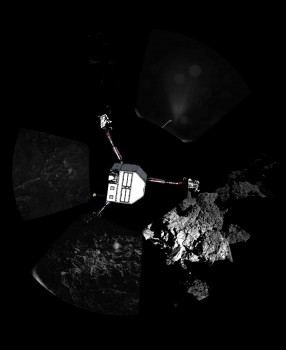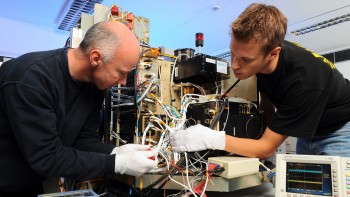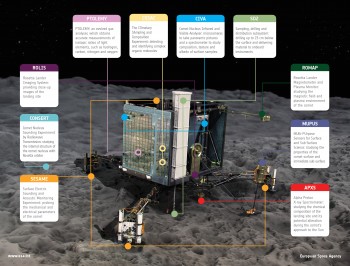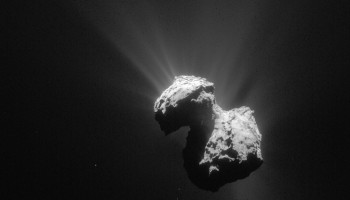Over the last few weeks, Rosetta has been flying along the terminator plane of Comet 67P/Churyumov-Gerasimenko, at distances from 180 km down to 153 km and at latitudes between 0 and 54 degrees, in order to find the best location to communicate with Philae.
However, over the weekend of 10–11 July, the star trackers again struggled to lock on to stars at the closer distances thanks to confusion due to dust particles in the comet’s increasingly-active environment. Because safety of the spacecraft is the first priority, it is therefore being moved back to safer distances of 170–190 km.

360º view around the point of Philae’s final touchdown. The three feet of Philae’s landing gear can be seen in some of the frames. Superimposed on top of the image is a sketch of the Philae lander in the configuration the lander team believed it was in November 2014. Credits: ESA/Rosetta/Philae/CIVA
No contact has been made with Philae since Thursday 9 July. The data acquired at that time are being investigated by the lander team to try to better understand Philae’s situation.
For example, included in the latest data set was information on the sunlight reaching the lander’s different solar panels.
“The profile of how strongly the Sun is falling on which panels has changed from June to July, and this does not seem to be explained by the course of the seasons on the comet alone,” explains Philae’s project manager, Stephan Ulamec at DLR.
One possible explanation being discussed at DLR’s Lander Control Center is that the position of Philae may have shifted slightly, perhaps by changing its orientation with respect to the surface in its current location. The lander is likely situated on uneven terrain, and even a slight change in its position – perhaps triggered by gas emission from the comet – could mean that its antenna position has also now changed with respect to its surroundings. This could have a knock-on effect as to the best position Rosetta needs to be in to establish a connection with the lander.
Another separate issue under analysis is that one of the two transmission units of the lander appears not to be working properly, in addition to the fact that one of the two receiving units is damaged.
Philae is programmed to switch periodically back and forth between these two transmission units, and after tests on the ground reference model, the team has sent a command to the lander to make it work with just one transmitter. As Philae is able to receive and accept commands of this kind in the “blind”, it should execute it as soon as it is supplied with solar energy during the comet’s day.
The current status of Philae remains uncertain and is a topic of on-going discussion and analysis. But in the meantime, further commands are being prepared and tested to allow Philae to re-commence operations. The lander team wants to try to activate a command block that is still stored in Philae’s computer and which was already successfully performed after the lander’s unplanned flight across to the surface to its final location. This “safe block” set of activities includes temperature measurements by the thermal probe MUPUS, measurements by ROMAP and SESAME, and analysis by PTOLEMY and COSAC in sniffing mode, and do not involve moving any mechanism on lander. No detailed commands are needed: if operated in the currently stored configuration, the “safe block” only needs to be activated.
If this commanding works, Philae could re-start its scientific measurements and, if a link is established with Rosetta, it would be able to send its data back to Earth, via the orbiter.
The team has already tried to ‘call’ ROMAP in a similar way to the commands sent to the CONSERT instrument earlier in the month, but so far no confirmation signal has been returned. The situation continues to be analysed with the available data.
“Philae is obviously still functional, because it sends us data, even if it does so at irregular intervals and at surprising times,” adds Stephan Ulamec. “Several times we were afraid that the lander would remain off – but it has repeatedly taught us otherwise”.
From the end of this week, Rosetta will begin alternating lander communication attempts with its own scientific observations of the comet, including exploration of the southern latitudes, which have only started to become illuminated in recent months.
“Studying these regions is an important part of our long-term science goals in the lead up to and beyond perihelion next month, when the comet is at its closest to the Sun along its orbit and activity will be at a maximum,” comments Nicolas Altobelli, acting Rosetta project scientist while Matt Taylor is on holiday.
“Although the mission will now focus its scientific priority on the orbiter, Rosetta will continue attempting – up to and past perihelion – to obtain Philae science packets once a stable link has been acquired,” adds Patrick Martin, Rosetta mission manager.
About Rosetta
Rosetta is an ESA mission with contributions from its Member States and NASA. Rosetta’s Philae lander is contributed by a consortium led by DLR, MPS, CNES and ASI.












Discussion: 17 comments
We laymen sit and watch in awe only partly understanding your accomplishment.
I keep my fingers crossed that at some point stable communication is once again established. Even if this does not happen it has been (and still is) an exceptionally successful mission.
And looking at other recent missions from other agencies, the Rosetta mission is pleasantly unpatriotic and a true Pan-European achievement.
To fix philae position isn’t possible to use it’s drilling tool down into surface?
I really wish link would be stable enough to make and receive photographs back from Philae. They could show us how much did the terrain changed around lander and if it’s lander itself that moved or rather terrain around it that changed?
I also wonder if they tried to use latest data from CONSERT to pinpoint Philae location? As far as I remember experiment worked on 9 July 2015, but I don’t know if Rosetta received signal from it, or did Philae do the measurements on it’s own? Perhaps pinpointing the location could help a little bit in establishing status of the lander through the combination of Rosetta photographs and housekeeping data from Philae?
we all have our fingers crossed and hope Philae resumes contact soon and the science experiments can continue
here in the UK we have been patiently waiting for 67P to be above the horizon in the morning sky, now at last it is almost there and soon we will be bale to photograph Philae’s home
Just wondering if panels on the orbiter could be oriented to reflect more light on to the most likely location of the lander. Might this explain the erratic communication from the lander, sun being reflected from orbiter to the lander.
This makes no sense. Sun got nothing to deal with communication between lander and orbiter.
Ronan, that would seem highly unlikely considering the orbiter is 150+ KM above the surface of the comet.
What data DID Philae send, at surprising intervals?
Dear Mission Mgr Patrick Martin:
NASA is working on a technology called NICER/SEXTANT. It uses the RF’s of quasars. Could Rosetta triangulate down to a lower altitude with these? I am realistic the chances are slim that it could.
Godspeed
No. There’s no point useing anything like that for navigating Rosetta. Even if it’d have hardware necessary and technology would be mature enough.
Just wondering how far the signals from Philae can travel? Could they travel as far as Mars where some of our orbiters there might pick them up?
It must be like a continuous storm on the comet’s surface now: With increasing ejection of clouds of dust, gas geysers all around and possibly even under the lander itself. The comet is also accelerating and getting hotter by the minute. So it’s not surprising, if boulders too, are moving on an extremely unstable comet’s surface. In short the lander is now in a very hazardous environment making any data collectable now, very important to the understanding of the nature of these hurtling rocks in space. I sincerely hope this data is retrieved. All in all, it has been a superb mission and I have enjoyed following these exciting developments. Well done!
I’m wondering if there is a chance Philae might be swept off the comet from the increased sublimation activity? That might create a chance to glean all it’s data before it drifts off to eternity.
Scientists already answered that during early press conferences, back in a days after landing. Lander is much more dense than comet itself, it’s relatively small and heavy, so sublimation cannot lift it from the surface. The only possible scenario where Philae would fly away is if either comet would tear itself in a half, or (in less likely scenario) a large portion of a ground with Philae would break apart from the comet. But one of the reasons for choosing large blob as a landing site was that it was the safest one from any such occurrence. So I wouldn’t worry – it won’t happen.
Hi guys, I hope you are too much busy analysing data you got over the week end to give us an update? Or did Philae’s antenna got so much dust it cnanot speak anymore?
Has all the modeling to date assumed Philae’s position is roughly in the area assumed in the reconstruction? The reconstruction was based on many assumptions, it seems like at this point a much greater area if not the entire comet should be considered – run a monte carlo of the known sun orientation and obstacles and see how many spots on the comet fit the data. I think it is much less likely that Philae is shifting around from contact to contact. Start with a clean unbiased sheet and use hard data to figure out where it is.
“The lander is likely situated on uneven terrain, and even a slight change in its position – perhaps triggered by gas emission from the comet – could mean that its antenna position has also now changed with respect to its surroundings.”
If there is enough thermal energy to trigger gas emissions, why is there not enough energy to power Philae’s solar panels?